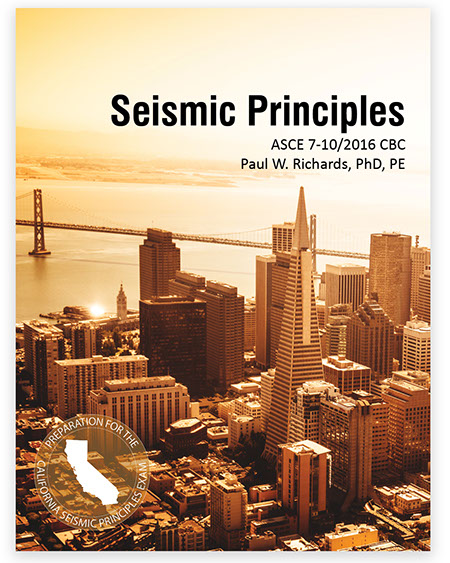Seismic Principles
Click on each chapter below to see which sections are available for preview.
1. Seismic Force-Resisting Systems
2. Basic Structural Dynamics
2.3 Single Degree of Freedom (SDOF) Model
2.4 Response History Analysis
2.5 Stiffness for SDOF Models
2.6 Elastic Response Spectra
2.7 Base Shear Force
2.8 Non-linear Response History Analysis
2.9 Ductility Demands
2.10 Constant Ductility Spectrum
2.11 Summary
3. Seismic Design Forces
3.2 Design Earthquake Spectrum Overview
3.3 Mapped Acceleration Parameters
3.5 Maximum Considered Earthquake Spectrum
3.6 Design Earthquake Spectrum
3.7 Building Code Intent and Risk Categories
3.8 Seismic Design Categories
3.9 Selecting Seismic Force-Resisting System
3.10 Equivalent Lateral Force Procedure and Seismic Base Shear
3.11 Response Modification Coefficient (R)
3.12 Seismic Importance Factor
3.13 Natural Period for Buildings
3.14 Seismic Weight
3.15 Computing the Design Base Shear
3.16 Vertical Distribution of the Base Shear Force
3.17 Summary
4. Flexible Diaphragm Analysis
4.1 Rigid and Flexible Diaphragms
4.2 Criteria for Flexible Diaphragms
4.3 Decomposing Resultant Forces
4.4 Forces on Lines of Resistance with Flexible Diaphragms
4.5 Lines of Resistance with Multiple Walls
4.6 Rigidity
4.7 Multi-story Buildings with Flexible Diaphragms
4.8 Diaphragm Design Forces
4.9 Diaphragm Shear Demand
4.10 Diaphragm Moments and Chord Forces
4.11 Collector Forces
4.12 Out-of-Plane Wall Forces and Subdiaphragm Analysis
4.13 Summary
5. Rigid Diaphragm Analysis
5.3 Center of Rigidity
5.4 Distribution of Torsion
5.5 Computing Frame Forces in Systems with Inherent Torsion
5.6 Accidental Torsion
5.7 Multi-story Buildings with Rigid Diaphragms
5.8 Cantilevered Diaphragms
5.9 Diaphragm Shear Demands
5.10 Diaphragm Moments and Chord Forces
5.11 Collector Forces
5.12 Semirigid Diaphragms
5.13 Summary
6. Load Combinations, Drift Limits, and Irregularities
6.4 Strength Design Load Combinations
6.5 Load Combinations with Earthquake Effects
6.6 Redundancy Factor
6.7 Working with the Strength Design Load Combinations
6.8 Allowable Stress Design Load Combinations
6.9 Capacity-Based Design
6.10 Load Combinations with Overstrength Factor
6.11 Story Drift Limits
6.12 Estimating Inelastic Story Drifts
6.13 Building Separation
6.14 P-Delta Effects
6.15 Horizontal Irregularities
6.16 Vertical Irregularities
6.17 Requirements for Buildings with Horizontal and Vertical Irregularities
6.18 Summary
7. Seismic Design with Wood
7.1 Introduction
7.2 Foundations, Lumber, and Anchors
7.3 Shear Wall Sheathing and Nails
7.4 Shear Wall Hold-downs and Openings
7.5 Diaphragm-to-Wall Connections
7.6 Diaphragm Design
7.7 Known Vulnerabilities
7.8 Summary
8. Seismic Design with Masonry
8.2 Masonry Seismic Force-Resisting Systems
8.3 Reinforcement for Masonry Shear Walls
8.4 Known Vulnerabilities for Masonry Buildings
8.5 Summary
9. Seismic Design with Concrete
9.1 Introduction
9.2 Reinforced Concrete Seismic Force-Resisting Systems
9.3 Seismic Detailing for Concrete Shear Walls
9.4 Seismic Detailing for Concrete Moment Frames
9.5 Known Vulnerabilities for Concrete Buildings
9.6 Summary
10. Seismic Design with Steel
10.1 Introduction
10.2 Steel Seismic Force-Resisting Systems
10.3 Seismic Detailing for Steel Braced Frames
10.4 Seismic Detailing for Steel Moment Frames
11. Nonstructural Components
11.2 Component Importance Factor
11.3 Operating Weight
11.4 Component Coefficients
11.5 Computing the Seismic Design Force for Nonstructural Components
11.6 Deformation Compatibility
11.7 Summary
12. Nonbuilding Structures
12.2 Nonbuilding Structures Attached to the Ground and Similar to Buildings
12.3 Nonbuilding Structures Attached to the Ground but Not Similar to Bldgs
12.4 Relatively Light Nonbuilding Structures Attached to Supporting Structrs
12.5 Heavy Nonbuilding Structures Attached to Supporting Structure
12.6 Summary
13. Professional Practice
13.1 Introduction
13.2 Professional Engineers Act
13.3 The Board Rules
13.4 Inspection, Testing, and Observation
13.5 ATC-20 Postearthquake Building Inspection
13.6 Summary
14. Preparing for the CA Seismic Principles Exam
14.1 Introduction
14.2 Seismic Principles Exam Test Plan
14.3 Suggestions for Rigorous Preparation
14.4 Suggestions for Non-Rigorous Preparation
14.5 Summary
